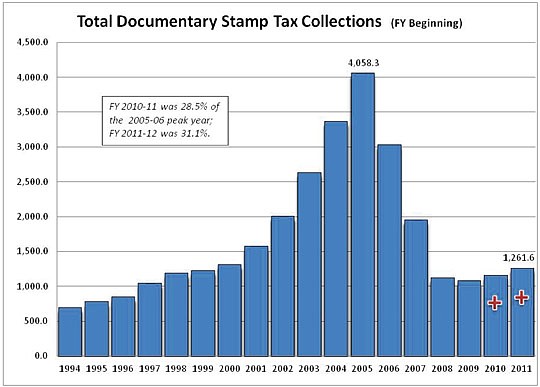
Florida's economy is improving, but it still has some catching up to do, according to a report filed last week by the Florida Legislature's Office of Economic and Demographic Research.
"Florida growth rates are gradually returning to more typical levels. But, drags are more persistent than past events, and it will take a few more years to climb completely out of the hole left by the recession," said the economic overview report.
Income, earnings
The report said personal income growth in the state was 0.4 percent from the second quarter to the third quarter of 2012, slightly below the national growth rate of 0.5 percent and ranking Florida 35th in the country.
"Manufacturing and construction continued to be among the state's weakest industry areas for earnings. In contrast, the arts, entertainment, recreation and retail trade industry areas performed strongly," it said.
Gross domestic product
The latest available figures for Florida's gross domestic product showed a growth rate of 0.5 percent in 2011, ranking the state 37th in the nation. That was the second straight year of positive growth after two years of declining state GDP, the report said.
However, "while the state's ranking improved (in 2011), the growth slowed from a downwardly revised 0.9 percent for 2010," it said.
Unemployment
Florida's unemployment rate in December 2012 was a seasonally adjusted 8 percent, higher than the national jobless rate of 7.8 percent, but better than 15 other states.
The state's unemployment rate has fallen from a peak of 11.4 percent in January and February 2010 and from 9.9 percent in December 2011.
At the peak of the recession, 52 Florida counties had double-digit unemployment rates but that number was down to three in December.
Unfortunately for Northeast Florida, the highest unemployment rate in the state is in Flagler County, at 11.2 percent. The Palm Coast area economy is highly dependent on housing construction, so the county has been hit hard by the market collapse.
Despite the improvement throughout the state, much of the decline in the jobless rate can be attributed to people dropping out of the labor force, the report said.
When people become frustrated and stop looking for work, they are not counted as part of the labor force and among the unemployed.
If the size of the labor force in December 2012 remained at the December 2011 level, Florida's unemployment rate would have been 8.9 percent, the report said.
"The job market will take a long time to recover – about 686,700 jobs have been lost since the most recent peak. Rehiring, while necessary, will not be enough," the report said.
"Florida's prime working-age population (aged 25-54) is forecast to add about 2,500 people per month, so the hole is deeper than it looks," it said.
"It would take the creation of about 1 million jobs for the same percentage of the total population to be working as was the case at the peak," it said.
Population growth
The report said population growth is "the state's primary engine of economic growth" and it is expected to strengthen. Florida's population is projected to grow by 1.2 percent annually between 2012 and 2015 and increase to 1.4 percent a year from 2015 through 2020, with most of the growth coming from net migration.
However, Florida's growth will not catch up to historical levels.
"The future will be different than the past; Florida's long-term growth rate between 1970 and 1995 was over 3 percent," the report said.
Still, Florida's population is expected to reach 20 million during 2016 and grow to 23.68 million by 2030. The population was 19.1 million in April 2012, it said.
"Florida's older population (age 60 and older) will account for most of Florida's population growth, representing 55.9 percent of the gains." it said. "Florida's younger population (age 0-17) will account for 14.9 percent of the gains."
Housing
Population growth should fuel a rebound in the housing market.
The report said there already are signs of a recovery in housing, including a 31.6 percent year-over-year increase in building permit activity through the first 11 months of 2012.
Also, the median sales price for existing homes reached a four-year high of $154,000 in December, although that's still well below the pre-recession peak.
The report said low home prices will "attract buyers and clear the inventory" as the economy improves.
A housing turnaround also will be helped by "long-run sustainable demand caused by continued population growth and household formation that has been pent-up," it said.
The continuing retirement of the baby boomers also will help demand for retirement homes, it said.
The one stumbling block to a housing recovery may be access to mortgage loans.
"While most areas of commercial and consumer credit are strengthening, residential credit still remains sluggish and difficult for consumers to access," the report said.
(904) 356-2466